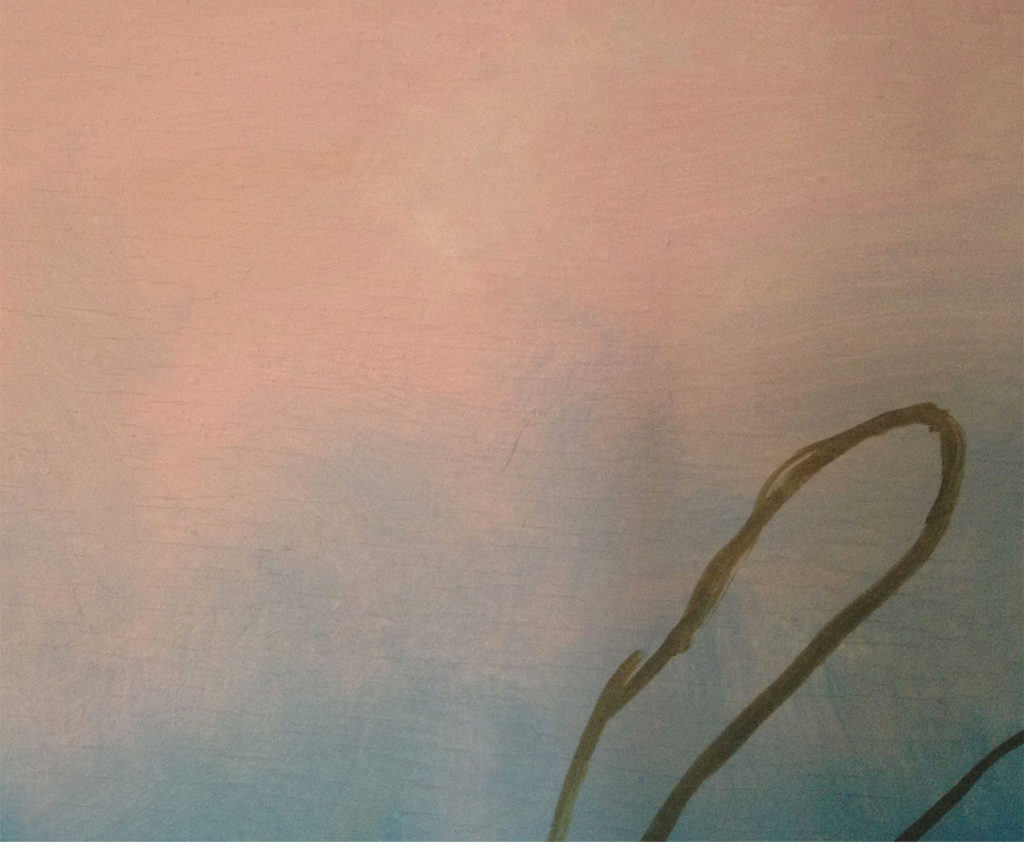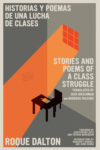
Art by Jenifer Evans (now Jasen Verefin)
This essay first appeared in the Full Stop Quarterly, Issue #7. To help us continue to pay our writers, please consider subscribing.
Felicia Felix-Mentor’s eyes are closed and her body is suspended in a moment. Zora Neale Hurston included her story in Tell My Horse (1938), her ethnographic study of vodou practices in Haiti and Jamaica. On October 24, 1936 a woman with no eyelashes and naked save for a cloth around her head, wandered into the village of Ennery, Haiti. She walked with a limp, causing the Mentor family to remember their daughter Felicia, who walked similarly due to a fracture in her left leg. Felicia had died of a sudden illness and had been buried nearly twenty-nine years earlier, in 1907. Her picture, taken by Hurston, unleashed frenzied debates around authenticity. Felicia was placed in a mental hospital, where she was diagnosed with schizophrenia. Hurston swore she had been zombified, but at the time most people pejoratively dismissed her writings as too fantastic to be believed.
Who is the Haitian zombie? One is created through a combination of herbal technology, an understanding of the supernatural realm, and an obliterating desire to control. A bokor (sorcerer or witch) provides the victim with a potion that induces a catatonic state resembling death. Believing their loved one to be deceased, the family performs a burial. Days later, the bokor returns to the grave in order to raise the dead: The victim is fed an antidote that revives them, though they no longer possess a will of their own. Earlier strains find the bokor digging up graves and reviving corpses via herbal and supernatural spells. In all versions, once brought back to life, the victim exists to labor for the material profit of their zombie master. (There is also another form of zombification, zombie astral, wherein a bokor will steal your soul, sealing it away in a bottle that can be kept or sold for personal gain.) The zombie is doomed to toil unless given salt, which acts as a curative, waking the captive from its trance, whereafter they immediately seek their grave. The myth is broadly accepted as a metaphor for slavery and colonialism—the combination of soul capture, control by a master, loss of agency and identity, and endless labor parallels the most recognizable aspects of experiences under slavery. Its increased significance in the cultural imagination post-Haitian Revolution telegraphs at least one overwhelming fear: a return to never-ending bondage, whether in life or in death.
I have been meditating on the meanings of the zombie ever since reading two works recently translated with empathetic care by Kaiama L. Glover into English: Dance on the Volcano by Marie Vieux-Chauvet and Hadriana in All My Dreams by René Depestre. Vieux-Chauvet and Depestre are seminal writers in Haitian literature and I am interested in the ways these two works talk to and hold one another. On the surface, their subjects have very little in common. Dance on the Volcano (1957) is a sprawling historical epic set in the late eighteenth century and centering on Minette, a real-life mixed-race opera singer in French colonial Saint-Domingue. (Known as the “Pearl of the Antilles,” Saint-Domingue was one of the richest colonial islands due to a sugar and coffee-based plantation economy powered by massive forced labor via the transatlantic slave trade.) Her rise to fame occurs alongside the revolutionary currents fueling the 1804 war of independence. Hadriana in All My Dreams (1988) is a smaller affair, though it drips with piercing social satire densely fused to a bawdy playfulness. The plot takes place mostly during the late thirties in Jacmel and involves Hadriana Siloé, the daughter of wealthy French parents, who seemingly dies on the altar during her marriage to a young Haitian man from a prominent family. Against the backdrop of Carnival, Hadriana is mourned and buried by the vibrant citizens of Jacmel. Her eventual zombification and disappearance cracks open a collective wound that is stubborn to heal. Depestre’s novel explicitly engages with the zombie myth and its stereotypes, threading a critical commentary on the uses and abuses of the living undead. On the other hand, Dance on the Volcano contains not one mention of zombies or zombification. But its story is set during a foundational moment in the myth, and it offers a particularly resonant, folkloric prism through which we can read Vieux-Chauvet’s work. Dance doesn’t shy away from the disturbing brutality seamlessly woven into Saint-Domingue’s everyday, where slaves, free people of color, maroons, poor and rich whites clashed in the pursuit of autonomy and dominance. Vieux-Chauvet’s textured renderings of this revolutionary period provides a glimpse into the volatile energies feeding and coalescing into myth.
•
The migration of the zombie myth was facilitated by the American Occupation of Haiti, which lasted from 1915 to 1934. Triggered by the island’s political instability, Americans swooped in to protect their economic investments, bringing along their racist assumptions and ulterior motives. During this period, autobiographical tales written by American Marines and other travelers satiated an overseas desire for exoticism and escapism; their biased narratives were readily accepted as sensational, semi-ethnographic accounts that removed the veil shrouding the “backward customs” of the first Black Republic. From there, the zombie infiltrated cinema, with films like White Zombie (1932) and I Walked With A Zombie (1943) loosely pulling from and reworking the myth as it is described in William Seabrook’s The Magic Island (1929), which is usually cited as the first formal introduction of the Haitian zombie to American audiences before its general invasion into pulp magazines and beyond. With every permutation the zombie lost its specificity, until it was entirely drained of context and whitewashed to fit foreign concerns.
The American zombie (flesh eating, violent horde, apocalyptic) is usually accepted as a repository for fears surrounding conformity, life under advanced capitalism, contamination, and the end of the world. What most of these Americanized portrayals lack is an active and transformative sense of rebellion. Sarah Juliet Lauro’s The Transatlantic Zombie: Slavery, Rebellion, and Living Death (2015) provides an evocative frame to see the refracting magick of the zombie and its appropriations. Interdisciplinary and passionately researched, her book charts the zombie’s spiraling history from its origins in African soul-capture myths to its forced migration to the New World, to its absorption into Haitian folklore and its subsequent “colonization” of the American psyche and beyond. Whether discussing textual, cinematic, or rhetorical zombies, Lauro remains attentive to the regenerative spark infusing the figure of the living undead, highlighting its radical potential for disruption and conversion. Within the Haitian zombie, she locates a sense of disempowerment but also the capacity for resistance. She insists the zombie both is and is not the slave. It is the slave because the conditions of Saint-Domingue facilitated its inception. It is not the slave because its meanings have expanded to include post-revolution Haiti, the American Occupation, Duvalierism (the authoritarian dictatorship that lasted for over twenty years), and more. The zombie’s recombinant propensity for adaptation proves to be its most beguiling characteristic—one Haitian writers have been discursively repurposing as a response to present-day pulses and struggles. Calling into question the singular meaning of the myth, Lauro charts the many valences of the folkloric zombie from social punishment to political subtext to symbolic revolution. Of particular interest is her discussion of the discursive zombie’s ability to process, reproduce, dismantle, and redirect history; embedded in this reading is an acknowledgement of how “the zombie dramatizes the way the dead still occupy the space of the living” (113). Writers like Ignace Nau, Jacques Stephen Alexis, and Frankétienne turned the zombie into a narrative tool, an alternative language in which to speak of and wrestle with knotted concerns around return and revision.
•
“Vieux-Chauvet’s novel also does something few histories of the Haitian Revolution do: it centers the story on women,” writes Laurent Dubois. Unfairly overshadowed by its French and American counterparts, the Haitian Revolution upends and complicates our static narratives around equality, liberty, fraternity, and the pursuit of happiness. It remains the most successful slave revolt in modern history and resulted in the creation of the first Black Republic, which became the first country in the Western hemisphere to abolish slavery. Dance on the Volcano breathes fresh air into a narrative (and resulting mythology) dominated by male heroics and tragics: Makandal, Toussaint, Pétion, Ogé. Vieux-Chauvet centers her novel on market women, actresses, concubines, daughters, and mothers. She captures the dizzying racial demarcations of the period and meticulously details how status is expressed and disrupted through clothing, hairstyle, and language. The novel opens with the silent tensions festering between white Creole and European women and free women of color, who have recently been banned by law from wearing shoes. They retaliate by decorating their feet with diamonds from their white lovers. Although not an example of zombism, the scene depicts a duality: The women obey the law and wear no shoes; they also disrupt the law by redirecting its original intentions. Vieux-Chauvet demonstrates a small moment of symbolic revolt, leading me to back to the discursive zombie’s capacity for combat. Whether conscious or not, most everyone in Dance is under some kind of trance. Jasmine, Minette’s mother, admonishes her daughters to speak French rather than their native Creole. Minette starts off “[t]hinking like a true freedwoman, she thanked God she had not been born a slave,” seeing in “them an inferior and pitiable class.” (18) She falls in love with LaPointe, a vengeful black landowner who treats his slaves as cruelly as white planters. His wounding sense of humiliation and lust for power pushes him to reproduce the very system causing his hate. Minette’s personal encounters with slavery (her mother’s past, LaPointe) and abolition (her relationship with revolutionary-minded neighbors who aid runaway slaves) force her to reconsider her previous ambivalence. By the end, her singing evolves to the point that it resembles the stirring marronage calls from the lambi shell, akin to the sounding bell of independence.
Dance is an early work, written twelve years before Vieux-Chauvet’s masterpiece Love, Anger, Madness, an agonizing indictment in three phantasmic tales of the emotional and spiritual upheavals attending life under François “Papa Doc” Duvalier. Dance lacks the trilogy’s unforgiving focus and gothic mood, but nevertheless stands as a brave experiment in mythmaking and historical revision. My mind cannot ignore the year of its publication—1957—the same year that Papa Doc was elected President. Set between 1791 and 1804, Dance is seemingly far removed from Vieux-Chauvet’s present. Or is it? The symbolic zombie animates itself in the subtle parallels between the colonial revolutionary period of the dawning nineteenth century and Vieux-Chauvet’s similarly combustible period signaled by the rise of Duvalier, who manipulated the rhetorics of populism and black nationalism for his own terrifying violent gain. Galvanized by the American Occupation and its denigration of Haitians as incapable of governing themselves, Duvalier’s appropriation of noirisme appeared to echo the revolutionary rebels of past, thanks to his insistence that political power be restored to the black rural class as opposed to the tiny mulatto elite. Vieux-Chauvet would later flee Haiti in fear of violent retaliation by Duvalier and his nightmarish paramilitary force, the Tonton Macoutes. With Dance, she depicts the formative bursts of revolt as if to prepare for the political and psychic reckoning to come.
•
This quote might be Depestre’s most repeated: “The history of colonization is the process of man’s general zombification. It is also the quest for a revitalizing salt capable of restoring to man the use of his imagination and culture.” Again, we are presented with a duality: living and death, freedom and captivity, automation and imagination. The constant search for salt that activates both awareness and insurgency. The zombie born of the Revolution has now infiltrated popular culture, history, and creative expressions, leaving in its wake prickly questions around the legacies of colonialism and imperialism. Hadriana in All My Dreams was published two years after the end of the Duvalier regime (signaled by the departure of Jean-Claude “Baby Doc” Duvalier to France). Whereas Vieux-Chauvet’s text feels written through a gathering storm, Hadriana offers a polyvocal mediation in the aftermath of devastation. Beneath the erotic surrealities and bombastic atmosphere, trembles portraits of psychic exhaustion, suspension, and resurgence. Deeply affected by Hadriana’s disappearance, her god-brother Patrick devotes his life to deciphering the enigmatic zombie. In chapters playing with form and conventions of folklore, Depestre zooms in on the zombie as a shorthand for historical return—an anxiety that the past is doomed to repeat in the present. Is slavery truly dead and buried? Like the carnival sequences, Hadriana parades through its pages spectres of now and then, approaching the historical as a malleable, collaborative process rather than an impenetrable fortress of foreclosure. By gesturing towards other zombies—both native and foreign, literal and metaphorical—Depestre admits to the continual interference of ghosts of the past, claiming the figure as both an expression of Haiti’s evolving cultural imaginary and as an inevitable feature of geographies marked by colonialism’s reviving shadow.
“. . . [T]he zombie represents the ultimate biological fuel—that which remains of Caliban after his loss of identity, his life having been cut literally in two . . .” The most stubborn of zombies, colonialism refuses to be laid to rest. Its tactics scramble and reorder to fit and exploit the vacillating tides of the moment. In Hadriana the villagers blame Jacmel’s deterioration on the “evaporation” of its white Creole fairy; her zombification is inhabited by the townspeople, each bringing to the tale the transference of their own hardship and heartache. While Depestre celebrates their capacity for revision, he complicates the town’s enthusiasm for Hadriana in his casting of her as a pale daughter of French colonials. Ironically, Hadriana’s true fate, as revealed in the last movement of the novel, brings into relief tensions around who is able to leave and who must stay, or what aids and/or forbids the tasting of salt.
•
Reading Vieux-Chauvet and Depestre unleashed me from the stagnancy of history through their enfolding of elements dismissed as less legitimate: narratives by women, folklore, magic, myth, eroticism, and more. Their blending of sources and inheritances, occurrences and reveries, past and present, creates fiction charged with the topsy-turvey reversals embedded in the carnival procession. Both novels look back from a present vantage point only to return with unsettling mysteries for the contemporary moment. Lauro opens one chapter with a line from Jacques Stephen Alexis: “Memory is a revenant of which we cannot be rid.” Like the zombie myth itself, it’s easy to read in this line endless entrapment. Dance on the Volcano and Hadriana in All My Dreams locate a generative ground between the ghostly zombie and activation, transforming the return into a kaleidoscopic moment of reinvention and synergy.
Allison Noelle Conner’s writing has appeared in Bitch, Full Stop, Jacket2, and elsewhere. She lives in Los Angeles, where she works at Jack Jones Literary Arts.
This post may contain affiliate links.







